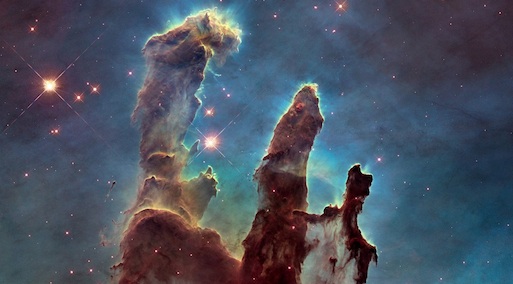The Hubble space telescope has captured an incredible new hi-def version of its most iconic photo – the Pillars of Creation, showing three light-year-long columns of cold gas in a distant galaxy bathed in the light of a cluster of young, massive stars.
[fwdevp preset_id=”8″ video_path=”hZ7zGUFDOsg”]The structures exist in a discrete region of the Eagle Nebula, or M16, 6500 light years from Earth. (A light year is approximately 10 trillion kilometres.)
The new, sharper images have been taken to mark the telescope’s 25th anniversary in April. This time, the pillars have been photographed in near-infrared light, as well as visible light. The infrared provides a view of the pillars as silhouettes against a background of a multitude of stars, Astronomy Now reports.
The clarity is achieved because the infrared light penetrates much of the gas and dust, except for the densest regions of the pillars.
Although the original image was dubbed the Pillars of Creation, the new image suggests they are, in fact, in the process of breaking down. “I’m impressed by how transitory these structures are,” says Paul Scowen of Arizona State University in Tempe. “The ghostly bluish haze around the dense edges of the pillars is material getting heated up and evaporating away into space. We have caught these pillars at a very unique and short-lived moment in their evolution.”
The Hubble telescope also thrilled spacegazers with its largest image ever assembled – a sweeping view of a portion of the Andromeda galaxy, our “galactic next-door neighbour”. The image features over 100 million stars, more than two million light years away and in a panorama stretching 61,000 light years.
Agencies/Canadajournal
 Canada Journal – News of the World Articles and videos to bring you the biggest Canadian news stories from across the country every day
Canada Journal – News of the World Articles and videos to bring you the biggest Canadian news stories from across the country every day



